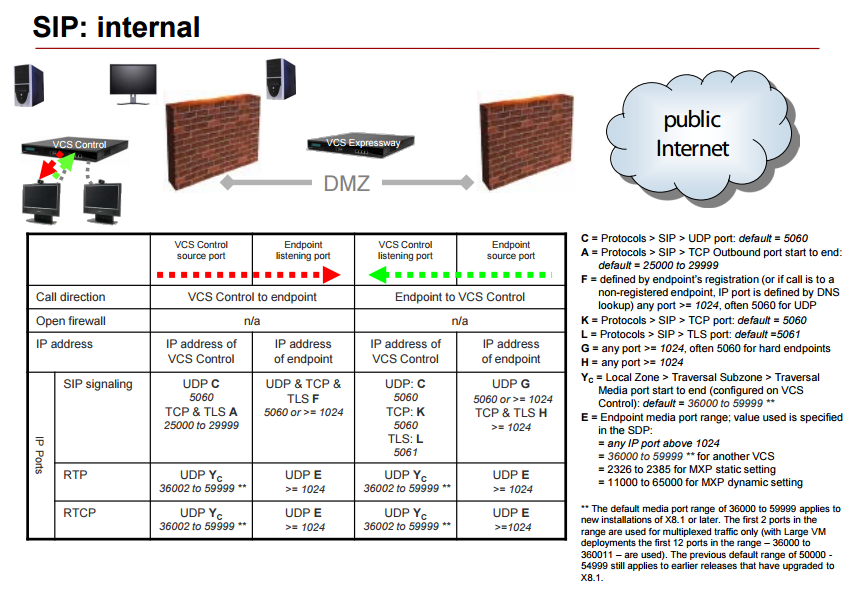- Cisco Community
- Technology and Support
- Collaboration
- TelePresence and Video Infrastructure
- Network Ports,communications VCS - Conductor-TS
- Subscribe to RSS Feed
- Mark Topic as New
- Mark Topic as Read
- Float this Topic for Current User
- Bookmark
- Subscribe
- Mute
- Printer Friendly Page
- Mark as New
- Bookmark
- Subscribe
- Mute
- Subscribe to RSS Feed
- Permalink
- Report Inappropriate Content
09-07-2015 02:05 AM - edited 03-18-2019 04:57 AM
Hello, I have a bit of confusion with this, in an internal conference call, involved two VC systems, VCS - concuctor- TPserver.
which are the ports and direction, in this called?
443,
5061 Sip signaling ? Endpoint:5061 ->VCS:5061->Condutor:5061->TPserver:?
media ports ? Endpoint <->VCS<->TPserver
thanks,
Solved! Go to Solution.
- Labels:
-
Room Endpoints
Accepted Solutions
- Mark as New
- Bookmark
- Subscribe
- Mute
- Subscribe to RSS Feed
- Permalink
- Report Inappropriate Content
09-08-2015 04:08 AM
See below diagram for reference.This is based on my understanding.

- Video endpoints will register to VCS using SIP TLS (secured) for call signaling.
- VCS and Conductor will communicate via neighbor zone using SIP TLS (secured).
- Conductor and TP Server/MCU will communicate using SIP TLS (secured) for call signaling and to support auto-dialed participant for the TP Server/MCU to know where to direct signaling request.
- Conductor and TP Server/MCU will communicate via HTTPS for the Conductor to manage the TP Server/MCU remotely.
- Media between video endpoint and conference bridge (TP server/MCU) will flow directly in both ways once call signaling is established.
For more details take a look at the deployment guide: http://www.cisco.com/c/dam/en/us/td/docs/telepresence/infrastructure/conductor/config_guide/xc3-0_docs/TelePresence-Conductor-Cisco-VCS-B2BUA-Deployment-Guide-XC3-0.pdf
regards,
Acevirgil
- Mark as New
- Bookmark
- Subscribe
- Mute
- Subscribe to RSS Feed
- Permalink
- Report Inappropriate Content
09-08-2015 06:13 AM
I missed something in the first diagram. Sorry for that. I already updated it.
- Video endpoint will start a session to VCS using the port >=1024 (any).
- VCS will listen at port 5061 for SIP TLS.
- Outbound SIP TLS port range for VCS is 25000-29999.
- Listening port for video endpoint will be port >=1024 (any).
- For RTP/RTCP/Media, once signaling and call flow between video endpoint, VCS and Conductor are complete, the call is set up and media flows directly between the endpoint and the conference bridge.
for details:

- On the example above, the RTP/RTCP/Media ports are different in this case. This is for traversal call from internal endpoint to VCS-C to VCS-E to external endpoint.
regards,
Acevirgil
- Mark as New
- Bookmark
- Subscribe
- Mute
- Subscribe to RSS Feed
- Permalink
- Report Inappropriate Content
09-08-2015 04:08 AM
See below diagram for reference.This is based on my understanding.

- Video endpoints will register to VCS using SIP TLS (secured) for call signaling.
- VCS and Conductor will communicate via neighbor zone using SIP TLS (secured).
- Conductor and TP Server/MCU will communicate using SIP TLS (secured) for call signaling and to support auto-dialed participant for the TP Server/MCU to know where to direct signaling request.
- Conductor and TP Server/MCU will communicate via HTTPS for the Conductor to manage the TP Server/MCU remotely.
- Media between video endpoint and conference bridge (TP server/MCU) will flow directly in both ways once call signaling is established.
For more details take a look at the deployment guide: http://www.cisco.com/c/dam/en/us/td/docs/telepresence/infrastructure/conductor/config_guide/xc3-0_docs/TelePresence-Conductor-Cisco-VCS-B2BUA-Deployment-Guide-XC3-0.pdf
regards,
Acevirgil
- Mark as New
- Bookmark
- Subscribe
- Mute
- Subscribe to RSS Feed
- Permalink
- Report Inappropriate Content
09-08-2015 04:08 AM
Great !!!
I have some doubts?
Video endpoint start session to VCS listen port 5061.
But,
VCS in your diagram , you point port 5061 , but in "local outbounds ports" in VCS , it should not be 25000-29999 ? Or Conductor start session whith VCS ?
In my list or VCS "local outbounds ports" , I do not have port 5061.
Thanks in advance
- Mark as New
- Bookmark
- Subscribe
- Mute
- Subscribe to RSS Feed
- Permalink
- Report Inappropriate Content
09-08-2015 06:13 AM
I missed something in the first diagram. Sorry for that. I already updated it.
- Video endpoint will start a session to VCS using the port >=1024 (any).
- VCS will listen at port 5061 for SIP TLS.
- Outbound SIP TLS port range for VCS is 25000-29999.
- Listening port for video endpoint will be port >=1024 (any).
- For RTP/RTCP/Media, once signaling and call flow between video endpoint, VCS and Conductor are complete, the call is set up and media flows directly between the endpoint and the conference bridge.
for details:

- On the example above, the RTP/RTCP/Media ports are different in this case. This is for traversal call from internal endpoint to VCS-C to VCS-E to external endpoint.
regards,
Acevirgil
- Mark as New
- Bookmark
- Subscribe
- Mute
- Subscribe to RSS Feed
- Permalink
- Report Inappropriate Content
09-09-2015 02:25 AM
Thanks for the support Acevirgil ,
one last point, although in the guide indicates> = 1024 for endpoint, Cisco equipment in TC7x ... , really would be port 5060/5061 ? for sip signaling.
- Mark as New
- Bookmark
- Subscribe
- Mute
- Subscribe to RSS Feed
- Permalink
- Report Inappropriate Content
09-09-2015 04:26 AM
I'm not an expert of Firewall devices but as per my understanding, Cisco TC7.x.x video endpoints will used any ports starting from 1024 to 65535 for SIP signaling. By default it will be 5060 or 5061.
For SIP registration and call setup/control signaling, video endpoints listens for SIP requests and SIP responses on the default trusted SIP ports (5060 for TCP and UDP or 5061 for TLS over TCP).
regards,
Acevirgil
Discover and save your favorite ideas. Come back to expert answers, step-by-step guides, recent topics, and more.
New here? Get started with these tips. How to use Community New member guide

